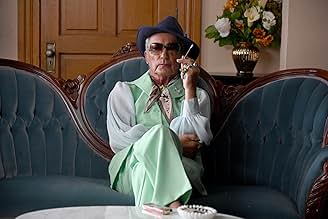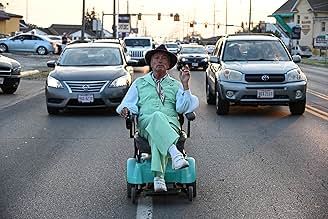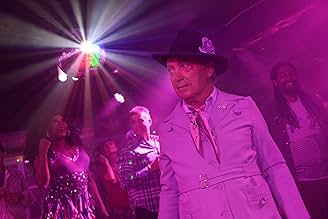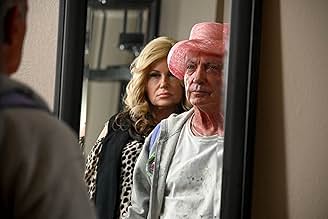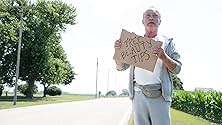NOTE IMDb
7,0/10
3,9 k
MA NOTE
Un coiffeur autrefois flamboyant fait une longue promenade à travers une petite ville pour coiffer les cheveux d'une femme morte.Un coiffeur autrefois flamboyant fait une longue promenade à travers une petite ville pour coiffer les cheveux d'une femme morte.Un coiffeur autrefois flamboyant fait une longue promenade à travers une petite ville pour coiffer les cheveux d'une femme morte.
- Récompenses
- 6 victoires et 16 nominations au total
Catherine L. Albers
- Janie
- (as Catherine Albers)
Avis à la une
A very touching film regardless of it's gay theme. That said, it's the gay theme that makes this film truly special.
This lovely slice of love film documents the life of a member of "the lost generation" of gay men, most of whom died during the AIDS crisis. Very few are left. And very few have had their lives dramatized in such a touching way.
This film also tells a fascinating story, in a very authentic way, of how a "flamboyant" gay man lived-or moreover "survived"- in a small American southern town during a time a few decades ago now when it was NOT okay at all to be gay, especially if your personality just so big than you could not hide your fabulous gayness no matter how much you tried.
Such men often had no choice other than to pursue one of a few select careers (florist, hairdresser, waiter, mortician, etc.) that society deemed "acceptable" for gay men, assuming you didn't announce your gayness to most people These jobs were often the ONLY choice for such gay men.
That said, if you could actually hide your homosexuality enough in a convincing way, you could pursue a other more mainstream career, but if you did, such careers were often cut short if you were discovered or "outed." And to add insult to injury, these outed men would not only lose their jobs, but they would often.face criminal charges, go to prison, and be shunned, their lives now ruined.
Most of these brave men (both in or out of the closet during these times) are now part of history, many tragically eventually dying in the 80s and early 90s from HIV-related illnesses.
Very few of this "lost generation" of gay men survive, and those that do probably still think no one would be interested in their story. How wrong they are. This movie proves that point.
Gratefully, we have arrived at a time that the public, and especially younger gay men, now actually want...and need...to hear these stories.
This film competently portrays one such story-a story of fabulousness but also of love and loss and the realities of living in those homophobic times, especially when AIDS created even more fear and distain for the gay community, especially in small town America.
This story is an important one, and an enjoyable and meaningful film to watch too. It has its sad moments, but also is an uplifting and inspiring story, a journey of this one amazing unapologetic gay citizen of a small town from a few decades "back in the day.".
I give it a bug 2 thumbs up. 👍🏼 👍🏼!
This lovely slice of love film documents the life of a member of "the lost generation" of gay men, most of whom died during the AIDS crisis. Very few are left. And very few have had their lives dramatized in such a touching way.
This film also tells a fascinating story, in a very authentic way, of how a "flamboyant" gay man lived-or moreover "survived"- in a small American southern town during a time a few decades ago now when it was NOT okay at all to be gay, especially if your personality just so big than you could not hide your fabulous gayness no matter how much you tried.
Such men often had no choice other than to pursue one of a few select careers (florist, hairdresser, waiter, mortician, etc.) that society deemed "acceptable" for gay men, assuming you didn't announce your gayness to most people These jobs were often the ONLY choice for such gay men.
That said, if you could actually hide your homosexuality enough in a convincing way, you could pursue a other more mainstream career, but if you did, such careers were often cut short if you were discovered or "outed." And to add insult to injury, these outed men would not only lose their jobs, but they would often.face criminal charges, go to prison, and be shunned, their lives now ruined.
Most of these brave men (both in or out of the closet during these times) are now part of history, many tragically eventually dying in the 80s and early 90s from HIV-related illnesses.
Very few of this "lost generation" of gay men survive, and those that do probably still think no one would be interested in their story. How wrong they are. This movie proves that point.
Gratefully, we have arrived at a time that the public, and especially younger gay men, now actually want...and need...to hear these stories.
This film competently portrays one such story-a story of fabulousness but also of love and loss and the realities of living in those homophobic times, especially when AIDS created even more fear and distain for the gay community, especially in small town America.
This story is an important one, and an enjoyable and meaningful film to watch too. It has its sad moments, but also is an uplifting and inspiring story, a journey of this one amazing unapologetic gay citizen of a small town from a few decades "back in the day.".
I give it a bug 2 thumbs up. 👍🏼 👍🏼!
It took 13 years but Todd Stephens finally return as a director with Swan Song. And personally, I think this is his best so far. Mainly because of the always charismatic Udo Kier who was able to defy the sometimes campy yet melancholic Stephens' narrative. While the film is sorely too subdued or moody for its own good, but at least it still has room for some moving and emotional moments.
SXSW 2021
Greetings again from the darkness. It's never too late. We've all heard the phrase, but is it accurate ... at least mostly? Writer-director Todd Stephens met the real life Pat Pitsenbarger in a small town gay bar, and he turned that person into this engaging story by casting the great Udo Kier in the lead. When we first meet Pat, he's living a life of daily drudgery in a nursing home. He's a curmudgeon whose hobbies are folding (perfectly) the paper napkins he takes from the cafeteria, and sneaking a smoke when no one is looking. We also see how tenderly he treats an incapacitated neighbor. It's not the last time we see his two sides.
Pat was once a renowned hairdresser in Sandusky, Ohio. When he is informed that a long-time former (wealthy) client has passed away, and her dying wish was for Pat to do her hair for the funeral, he sneaks out of the home and begins a road trip down memory lane. Despite Pat spending the time on foot, the film has the feel of a true road trip movie as he crosses paths with many folks - some new and some with ties to his previous life. One of his first stops is the graveyard to visit his life partner who died of AIDS. We realize Pat still grieves.
There is a hilarious stop at a convenience store as he tries to knock off the items on his shopping list for the project. Since he has no money, Pat depends on the kindness of others ... and his own sticky fingers. As he makes his way through town, some folks remember him, while others remind him of how long he's been gone and how much has changed. His house and business may be gone, but his memories remain.
Two folks from his past generate tremendous scenes. Pat confronts Dee Dee Dale (a reserved Jennifer Coolidge) who gets to tell her side of the story of their unpleasant business split so many years ago. Even better is a "conversation" in the park with his old friend Eunice (a superb Ira Hawkins). The two old friends toast the bygone days of their gay club, while also acknowledging the new world of the gay community. It's a touching sequence.
But the most surprising portion of the film occurs at the funeral home, where Pat imagines a final chat with that recently deceased client, Rita Parker-Sloan. What a pleasant surprise (actually shock!) to see Linda Evans back on screen. She is terrific in her brief appearance and we've really missed her over the last 23 years. But this film belongs to Udo Kier, and he kills. Pat is known as "The Liberace of Sandusky" and Kier embraces all that entails. This is a sentimental story punctuated by a spirited performance - and a Shirley Bassey song!
Pat was once a renowned hairdresser in Sandusky, Ohio. When he is informed that a long-time former (wealthy) client has passed away, and her dying wish was for Pat to do her hair for the funeral, he sneaks out of the home and begins a road trip down memory lane. Despite Pat spending the time on foot, the film has the feel of a true road trip movie as he crosses paths with many folks - some new and some with ties to his previous life. One of his first stops is the graveyard to visit his life partner who died of AIDS. We realize Pat still grieves.
There is a hilarious stop at a convenience store as he tries to knock off the items on his shopping list for the project. Since he has no money, Pat depends on the kindness of others ... and his own sticky fingers. As he makes his way through town, some folks remember him, while others remind him of how long he's been gone and how much has changed. His house and business may be gone, but his memories remain.
Two folks from his past generate tremendous scenes. Pat confronts Dee Dee Dale (a reserved Jennifer Coolidge) who gets to tell her side of the story of their unpleasant business split so many years ago. Even better is a "conversation" in the park with his old friend Eunice (a superb Ira Hawkins). The two old friends toast the bygone days of their gay club, while also acknowledging the new world of the gay community. It's a touching sequence.
But the most surprising portion of the film occurs at the funeral home, where Pat imagines a final chat with that recently deceased client, Rita Parker-Sloan. What a pleasant surprise (actually shock!) to see Linda Evans back on screen. She is terrific in her brief appearance and we've really missed her over the last 23 years. But this film belongs to Udo Kier, and he kills. Pat is known as "The Liberace of Sandusky" and Kier embraces all that entails. This is a sentimental story punctuated by a spirited performance - and a Shirley Bassey song!
Other reviews say it better but I'll say it with less words. Watch this and enjoy! It's a great film with a beautiful story.
I really loved this movie. I rarely watch any GL movie, but today i just happened to click on this movie and i shed tears at the end. Thank Mr Stephens. The movie has brought me back to many many many memories. I have gone through the AIDS crisis where many of my friends had died. We are the survivor and in death or near death we start forgiving. Udo Kier.is really really a good actor. I love Jennifer Coolidge. And Linda Evans all portrayed how old age is like and i am getting to be in the twilight of my age and i feel for all of them walking on the same steps. Again, my life started have its meaning after watching this movie. And I need to thank all of the people who made this movie possible. Thanks!
Le saviez-vous
- AnecdotesThe town in the film, Sandusky, Ohio, is the real life home-town of writer and director Todd Stephens.
- GaffesWhen Patrick visits the site of his old home, his hat disappears and then appears again when he leaves.
- Citations
Pat Pitsenbarger: Bury her with bad hair.
- Bandes originalesSupersonic Love
Written by Eddie Warner
Courtesy of FirstCom Music
Performed by L'ILLUSTRATION MUSICALE
Meilleurs choix
Connectez-vous pour évaluer et suivre la liste de favoris afin de recevoir des recommandations personnalisées
- How long is Swan Song?Alimenté par Alexa
Détails
Box-office
- Montant brut aux États-Unis et au Canada
- 126 110 $US
- Week-end de sortie aux États-Unis et au Canada
- 26 855 $US
- 8 août 2021
- Montant brut mondial
- 177 206 $US
Contribuer à cette page
Suggérer une modification ou ajouter du contenu manquant




